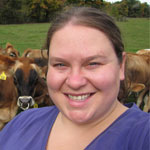
Every dairy farmer is striving for the same thing: the prefect cow. She milks better than any other cow and her components are 5 percent fat and 4 percent protein. She’s obviously pretty. She’s scored 90 points right now, but she’ll settle in at 96 by the time she’s 15 years old. She’ll reach that ripe old age because her health and productive life is off the charts. And obviously, each year, she’ll calve on the same exact day.
She’s the perfect cow in every way. Now that we know who she is, how do we get there?
I hear all different kinds of philosophies when it comes to breeding programs. Some say we should breed for bigger cows that can eat more so they can milk more. Others say if you breed for type you can manage for milk. Some just breed for milk, because that’s where the money’s at, right? Honestly, I’m pretty sure there’s only one way to get there. You breed for both.
For example, I have a cow named Bening whose production isn’t stellar for our herd. She’s projected to make 16,117 pounds of milk, which is more than 2,000 pounds below average for our Jersey herd, but her components are above average at 4.1 percent protein and 5.8 percent fat. With a high udder and wide teats, she’s traditionally been bred to a bull with good teat placement and higher milk yield potential.
Reflector, on the other hand, is going to make almost 25,000 pounds of milk this lactation with a 3.5 percent protein and almost 4.5 percent fat — not bad considering how much milk she’s making. Her udder, however, needs some work. Considering we’ve had to milk her on a set of 4-by-6 boards for the last two lactations, we’ve been breeding her to the best udder conformation bulls we can find.
Let me be blunt, this is my opinion.
When it comes to breeding programs, everyone has their own idea of what works, but I’ve never understood why someone would choose between milk or type when you can choose both. It feels like common sense. If a cow is lacking, breed her to a bull that picks up her slack. Parents want their kids to be better than they themselves were. Using A.I., that’s what we can do for our cows’ next generation. We can make them better. Type and production. Note that I’m saying and, not or.

The author dairies in partnership with her parents and brother at Spruce Row Farm in Pennsylvania. Jessica is a graduate of Pennsylvania State University, and since 2015, she has been active in promoting dairy in her local community. You can find her and her 250 Jersey cows on Facebook at Spruce Row Dairy or on Instagram at @seejessfarm.








